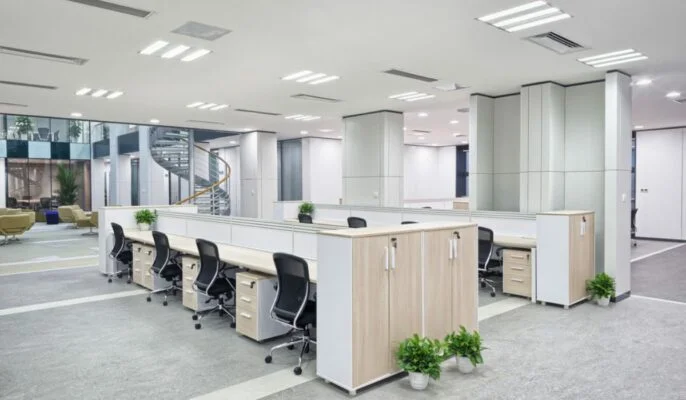The landscape of office seating is undergoing a transformative evolution driven by a growing emphasis on employee well-being and productivity. Innovations in office seating are at the forefront of this shift, redefining the traditional concepts of ergonomics and comfort. This article delves into the exciting developments and futuristic trends that represent the next frontier in office seating. We offer a glimpse into the future of ergonomic design and workplace comfort.
Dynamic Ergonomics:
The future of office seating lies in dynamic ergonomics that adapt to the ever-changing needs of the workforce. Chairs equipped with sensors and responsive mechanisms adjust in real-time to the user’s movements, providing continuous support and promoting optimal posture. This innovation ensures that employees experience personalized comfort throughout their workday.
Artificial Intelligence Integration:
Artificial Intelligence (AI) is making its mark on office seating by learning and adapting to individual preferences. Bright chairs with AI algorithms analyze user behavior, such as sitting habits and posture, to adjust automatically. This level of customization optimizes ergonomic support and enhances overall comfort, creating a seamless and intuitive seating experience.
Pressure-Sensing Surfaces:
Pressure-sensing surfaces embedded in office furniture and office chairs provide valuable insights into how employees interact with their seating. These surfaces detect pressure points and areas of discomfort, enabling chairs to adjust automatically. The result is a more responsive and user-centric seating solution that actively prevents discomfort and promotes musculoskeletal health.
Biometric Integration:
Integrating biometric technology takes office seating to a new level of personalization. Chairs equipped with biometric sensors can measure vital signs such as heart rate, stress levels, and even fatigue. This data is then used to fine-tune the chair’s settings, ensuring that it actively supports the user’s well-being and helps mitigate the adverse effects of prolonged sitting.
Adaptive Materials and Fabrics:
Innovations in materials and fabrics enhance the comfort and durability of office seating. Adaptive materials respond to the user’s body temperature, ensuring a comfortable sitting experience in various climates. Additionally, fabrics with moisture-wicking and antimicrobial properties contribute to a healthier and more hygienic workspace.
Flexible and Active Seating:
A departure from static chairs marks the future of office seating. Flexible and active seating options, such as balance ball chairs and kneeling stools, encourage constant micro-movements. This dynamic approach to sitting promotes core engagement, improves circulation, and reduces the negative impact of sedentary behavior on overall health.
Augmented Reality (AR) in Seating Design:
Augmented Reality (AR) is finding its way into office seating design. AR applications enable users to visualize how different chairs will fit into their workspace, considering factors such as size, style, and ergonomic features. This technology enhances the selection process, allowing for more informed decisions based on individual preferences and workspace constraints.
Collaborative Seating Solutions:
The future of office seating is collaborative, with innovative designs that facilitate teamwork and communication. Modular seating arrangements, convertible furniture, and movable partitions create dynamic workspaces that adapt to various collaboration needs. These solutions contribute to a more agile and interactive work environment.
Energy-Harvesting Seating:
Energy-harvesting technologies integrated into office chairs harness the energy generated by user movements. This energy can be stored and used to power embedded sensors and intelligent features or even charge electronic devices. Energy-harvesting seating not only promotes sustainability but also reduces the reliance on external power sources.
Customizable 3D-Printed Chairs:
The era of customizable 3D-printed office furniture is on the horizon. Companies are exploring the potential of 3D printing to create bespoke office chairs tailored to an individual’s body shape and ergonomic preferences. This revolutionary approach ensures a perfect fit, optimizing comfort and support for each user.
Haptic Feedback for Posture Correction:
Haptic feedback technology is incorporated into office chairs to provide real-time posture correction. When users adopt unhealthy sitting positions, the chair offers subtle vibrations or nudges to encourage proper alignment. This innovation serves as a proactive measure to prevent the development of poor sitting habits.
Inclusive and Accessible Designs:
The future of office seating is characterized by inclusive and accessible designs that cater to a diverse workforce. Chairs with adjustable features, intuitive controls, and options for different body types ensure that every employee can enjoy a comfortable and supportive seating experience, regardless of individual needs or abilities.
Conclusion:
Innovations in office seating are shaping a future where comfort, ergonomics, and adaptability converge to create a harmonious and dynamic work environment. From AI integration and biometric sensors to 3D printing and haptic feedback, the next frontier in office seating is personalization and user-centric design. As organizations prioritize the well-being and productivity of their workforce, these futuristic trends in office seating promise to revolutionize how we approach comfort and ergonomics in the workplace. The future of office seating is not just about sitting; it’s about experiencing a tailored and supportive journey through the workday.













